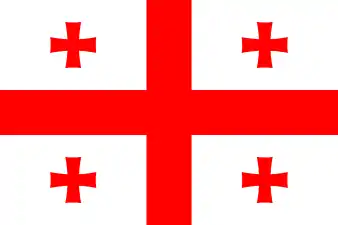Bolnisi
Bolnisi (Georgian: ბოლნისი), is a city in the country of Georgia, located in the Kvemo Kartli region and capital of the Bolnisi district. It currently has an estimated 13,800 inhabitants.
Bolnisi
ბოლნისი | |
|---|---|
 | |
 Flag  Seal | |
 Bolnisi  Bolnisi | |
| Coordinates: 41°27′N 44°32′E | |
| Country | |
| Mkhare | Kvemo Kartli |
| Municipality | Bolnisi |
| Elevation | 420 m (1,380 ft) |
| Population (2014[1]) | |
| • Total | 8,967 |

History
Bolnisi, originally known as Choruk Gamarli (Azerbaijani: Çörük Qəmərli), was settled by 95 German colonist families from Swabia in 1818, whilst part of the Georgia Governorate of the Russian Empire. Following the arrival of the German colonists, the town was renamed to Ekaterinenfeld (Russian: Катариненфельд), in honor of the sister of Tsar Alexander I, Ekaterina Pavlovna. Some eight years later, Ekaterinenfeld was pillaged by Kurds, who burned down the German colony and massacred most of its inhabitants.[2]
Following the Russian Revolution and the Sovietization of Georgia in 1921, Ekaterinenfeld was eponymously renamed to Luxemburg (Russian: Люксембург) for the renown German communist Rosa Luxemburg. In 1941, in accordance with Stalin's callous policy on ethnic groups, all Germans residents of Luxembourg who were not married to ethnic Georgians were deported to Siberia and Kazakhstan. on 3 April 1943, the town was finally renamed to Bolnisi, which remained unchanged after the fall of the Soviet Union.
On 31 December 1967, the settlement of Bolnisi received the status of a city.[3] In 1980, the city water supply network was built.
An airfield near the city was reported to have been bombed by Russia on August 8, 2008, during the Russia-Georgia war.[4]
Economy
The main occupations of the colonist Germans were viticulture, horticulture, fruit growing and cattle breeding. At the same time, irrigation, underground drainage and irrigation canals were constructed in Ekaterinenfeld, as well as wine, cognac and cheese factories, and leather and furniture factories. The town's contemporary economy is mostly agrarian with the notable exceptions of a winery, brewery, and a gold mine in the nearby village of Kazreti.
Religion and Cultural Heritage
Bolnisi has long been the seat of a bishop or archbishop, and is the home of the oldest dated Christian structure in Georgia.[5] It is known as Bolnisi Sioni (Sioni being Georgian for Zion and a designation used by many of their churches). This three-nave basilica church dates to the 5th century AD and features some pagan elements in its stonework. The original roof is missing but has been replaced with a modern covering.
A dedication Bolnisi inscriptions from the Bolnisi church, carved in the late 5th century, is one of the oldest dated specimens of Georgian writing. It mentions Bishop David of Bolnisi and two Sassanid kings Peroz I and Kavadh I.[5]
There are still remnants of the German past in Bolnisi. A small graveyard and plaque acknowledges the German influence in the village. A small street called Mill Street has evidence of 19th-century German architecture and a few signs in the German language that date from the early 20th century.
Sport
Whilst a German colony within the Russian Empire, Bolnisi had cycling, gymnast, and football teams in the 19th century.
Sioni Bolnisi, a football club founded in 1936, play at the Tamaz Stepania Stadium, named after local footballer Tamaz Stepania; they were league champions once in 2006.
Climate
| Climate data for Bolnisi (1981–2010) | |||||||||||||
|---|---|---|---|---|---|---|---|---|---|---|---|---|---|
| Month | Jan | Feb | Mar | Apr | May | Jun | Jul | Aug | Sep | Oct | Nov | Dec | Year |
| Record high °C (°F) | 20.2 (68.4) |
21.8 (71.2) |
27.7 (81.9) |
35.0 (95.0) |
32.6 (90.7) |
36.2 (97.2) |
39.0 (102.2) |
39.0 (102.2) |
36.8 (98.2) |
31.0 (87.8) |
26.5 (79.7) |
22.2 (72.0) |
39.0 (102.2) |
| Average high °C (°F) | 6.8 (44.2) |
7.7 (45.9) |
12.2 (54.0) |
17.9 (64.2) |
22.2 (72.0) |
27.1 (80.8) |
30.6 (87.1) |
30.3 (86.5) |
25.6 (78.1) |
18.8 (65.8) |
12.3 (54.1) |
7.9 (46.2) |
18.3 (64.9) |
| Daily mean °C (°F) | 1.8 (35.2) |
2.6 (36.7) |
6.6 (43.9) |
12.2 (54.0) |
16.4 (61.5) |
21.0 (69.8) |
24.5 (76.1) |
24.2 (75.6) |
19.7 (67.5) |
13.7 (56.7) |
7.5 (45.5) |
3.2 (37.8) |
12.8 (55.0) |
| Average low °C (°F) | −2.0 (28.4) |
−1.4 (29.5) |
2.1 (35.8) |
7.2 (45.0) |
11.1 (52.0) |
15.4 (59.7) |
18.8 (65.8) |
18.6 (65.5) |
14.4 (57.9) |
9.2 (48.6) |
3.5 (38.3) |
−0.5 (31.1) |
8.1 (46.6) |
| Record low °C (°F) | −14.8 (5.4) |
−13.5 (7.7) |
−9.0 (15.8) |
−6.3 (20.7) |
0.6 (33.1) |
6.0 (42.8) |
9.6 (49.3) |
9.0 (48.2) |
4.5 (40.1) |
−1.5 (29.3) |
−6.0 (21.2) |
−14.4 (6.1) |
−14.8 (5.4) |
| Average precipitation mm (inches) | 17.1 (0.67) |
26.2 (1.03) |
42.1 (1.66) |
64.3 (2.53) |
78.5 (3.09) |
66.6 (2.62) |
32.3 (1.27) |
34.9 (1.37) |
38.5 (1.52) |
50.5 (1.99) |
35.1 (1.38) |
20.9 (0.82) |
512.3 (20.17) |
| Source: World Meteorological Organization[6] | |||||||||||||
References
- "Population Census 2014". www.geostat.ge. National Statistics Office of Georgia. November 2014. Retrieved 28 June 2021.
- "Донские казаки и армянсков население в обороне русских границ" (PDF).
- "Болниси". БСЭ.
- https://news.yahoo.com/s/ap/20080808/ap_on_re_eu/georgia_south_ossetia_28;_ylt=AmbBKrNHVd8FYkuYULUW5J9bbBAF
- Rapp, Stephen H. (2003), Studies In Medieval Georgian Historiography: Early Texts And Eurasian Contexts, p. 316. Peeters Bvba, ISBN 90-429-1318-5.
- "World Meteorological Organization Climate Normals for 1981–2010". World Meteorological Organization. Archived from the original on 9 October 2021. Retrieved 9 October 2021.
External links
- A blogpost with fotos of former "german" houses in Bolnisi
- Tourism in Bolnisi

